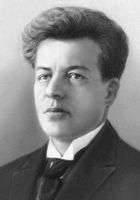Pyotr Voykov
| Pyotr Lazarevich Voykov Пётр Ла́заревич Во́йков | |
|---|---|
 | |
| Born |
Пётр Ла́заревич Во́йков Pyotr Lazarevich Voykov 13 August 1888 Kerch, Russian Empire |
| Died |
7 June 1927 (aged 38) Warsaw, Poland |
| Cause of death | Assassination |
| Resting place | Kremlin Wall Necropolis |
| Nationality | Russian, Soviet |
| Alma mater | University of Geneva |
| Known for |
Participation in shooting of the Romanov family Organisation of assassination attempt on Ivan Dumbadze |
| Title |
Petrus (Пётрусь) The Intellectual (Интеллигент) The Blonde (Белокурый) |
| Political party | Bolshevik, Communist Party |
Pyotr Lazarevich Voykov (Russian: Пётр Ла́заревич Во́йков; party aliases: Пётрусь and Интеллигент, or Piotrus and Intelligent) (August 13 [O.S. August 1] 1888 – June 7, 1927) was a Soviet revolutionary and diplomat.
Biography
He was born into Ukrainian[1][2][3] family. His father was a mining engineer[4] (or, according to other sources, a seminar teacher[5]), Voikov became involved in revolutionary activity on the side of the Mensheviks at the age of 15. Following a botched attempt on the life of the mayor of Yalta, he was expelled both from grammar school and later from the St. Petersburg Mining Institute. He went into exile in Switzerland, where he graduated from the University of Geneva.
On returning to Russia in August 1917, he joined the Bolsheviks and was appointed People's Commissar for Government Supply for the Ural region in 1918, where he was known by his party code name of "The Intellectual". He subsequently became an important member of the Ural Soviet and was put in charge of prodrazvyorstkas – the Bolshevik practice of grain confiscation. He knew N. N. Ipatiev, and had visited the Ipatiev House before it was selected as the final residence of Nicholas II of Russia and his family.
It seems to have been on the basis of information supplied by Voikov that Ipatiev was summoned to the office of the Soviet at the end of April 1918 and ordered to vacate what was soon to be called 'The House of Special Purpose.' During the imperial family's imprisonment in late June, Voikov dictated the smuggling of letters written in French to the Ipatiev House claiming to be a monarchist officer seeking to rescue them, composed at the behest of the Cheka.[6] These fabricated letters, along with the Romanov responses to them (written either on blank spaces or on the envelope), were ultimately used by Lenin's government to justify murdering the imperial family.[7] Clearly party to the decision to execute the royal family, Voikov was given the specific task of arranging for the disposal of their remains, obtaining 570 litres (150 US gal) of gasoline and 180 kilograms (400 lbs) of sulphuric acid, the latter from the Yekaterinburg pharmacy. After the killings, he was to declare that "The world will never know what we did with them." Voykov was a witness but later claimed to have taken part in the murders, looting from a dead grand duchess.[8] His role in the regicide was fully investigated by the commission set up after Admiral Kolchak's White Army captured Yekaterinburg from the Bolsheviks.
Back in Moscow in 1920, Voykov presided over the sales of the imperial treasures from the Kremlin Armoury and the Diamond Fund including Fabergé Eggs which found their way abroad. Voykov was appointed Soviet "plenipotentiary representative" in Poland in October 1924, and was assassinated in Warsaw in 1927 by Boris Koverda – an 18-year-old son of a White Russian monarchist and pupil of the Russian Gymnasium (High School) from Wilna. The killing has been later justified as the revenge for Voykov's part in the killing of the Tsar and his family. Voikov's body was transported to Moscow to be buried on Red Square.
This incident further damaged Soviet-Polish relations, already soured by the Polish-Soviet War of 1921. The Soviets broke off negotiations about a non-aggression pact (they would be resumed in 1931), accusing Poles of supporting the anti-Soviet White resistance.
The Soviet authorities cherished his memory, giving his name to the Moscow Metro station Voikovskaya, several streets and plants, and a coal mine in Ukraine. After the canonization of the royal family, the Russian Orthodox Church urged the authorities to erase the name of the "regicide and infanticide" from public objects. On July 17, 2007, the remembrance day of the Russian Royal Family, several Orthodox groups publicly prayed that the metro station in Moscow might be renamed.[9]
See also
- Alexander Griboyedov, Russian ambassador to Persia, assassinated in 1829
- Vatslav Vorovsky, Soviet envoy at the Conference of Lausanne, assassinated in 1923
- Andrei Karlov, Russian ambassador to Turkey, assassinated in 2016
References
- ↑ Керчь — это мой город
- ↑ Международный институт генеалогических исследований
- ↑ Г. Н. Губенко «Пётр Лазаревич Войков». Краткий биографический очерк. Симферополь: Крымиздат, 1959
- ↑ Войков, Пётр Лазаревич//Большая Советская энциклопедия
- ↑ Владимир Ростиславович Мединский - Справка о деятельности П.Л. Войкова
- ↑ Helen Rappaport, p. 125
- ↑ Helen Rappaport, p. 120
- ↑ Rappaport, p. 194
- ↑ Moscow disputes over metro station named after Royal Family murderer :: Russia-InfoCentre at www.russia-ic.com
- Victor Alexandrov, The End of the Romanovs, English edition, Hutchinson, London, 1966.
- Edvard Radzinsky. The Last Tsar: the Life and Death of Nicholas II, Doubleday, 1992. ISBN 0-385-42371-3.
- Robert K. Massie. Nicholas and Alexandra, reprint, Black Dog & Leventhal Publishers, 2005. ISBN 1-57912-433-X.
- (in Polish) 75 rocznica podpisania w Moskwie polsko-sowieckiego paktu o nieagresji, PAP, 2007-07-23
- Helen Rappaport, Ekaterinburg: The Last Days of the Romanovs, 2008, ISBN 978-0-099-52009-2.